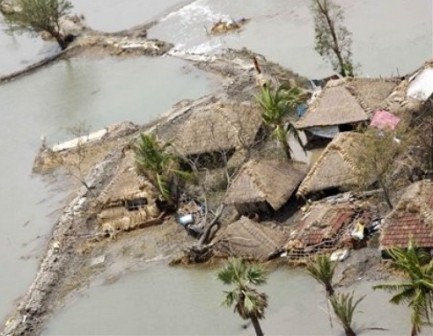India cyclone death toll reaches 100, situation grim
 New Delhi - The death toll from cyclone Aila that pummelled India's West Bengal state reached 100 as the affected regions faced a severe drinking water crisis while power-outages led to protests in the state capital Kolkata, news reports and officials said Thursday.
New Delhi - The death toll from cyclone Aila that pummelled India's West Bengal state reached 100 as the affected regions faced a severe drinking water crisis while power-outages led to protests in the state capital Kolkata, news reports and officials said Thursday.
Three days after the cyclone hit India's eastern coastal region leaving a trail of destruction in its wake, vast areas remained submerged, affecting a total of 5.1 million people.
Quoting official sources, the IANS news agency reported the death toll had touched 100 even as thousands of cyclone victims complained of lack of relief.
The West Bengal government confirmed the toll had increased to 96, as bodies of villagers were found across various parts of the state.
"The death toll may be higher since more bodies may be recovered. Rescue teams are continuing operations in remote coastal areas," disaster management official Shontonu Ray said over telephone from Kolkata.
Among the worst-hit districts were the coastal South 24 Parganas and the North 24 Parganas districts where 36 deaths had occurred, government figures showed.
Twenty-six people died in the famed Darjeeling tea district in northern Bengal after the cyclonic system caused heavy rains, triggering landslides on Tuesday.
Kolkata and nine other districts reported the remaining deaths. Most of the victims were killed as houses and trees collapsed, officials said.
The state government carried out rescue operations in the coastal Parganas districts where large swathes of land still lay submerged.
The putrid smell of rotting animal carcasses rent the air and saline water from the sea got mixed with river water to inundate villages, leading to a drinking water crisis in the districts.
There were some reports of a diarrhoea breakout, but there was no official confirmation. Victims complained that relief had not reached them, and the air-dropped food packets mostly went to waste, the IANS said in its report.
According to the state government, an estimated 249,371 houses, mostly thatched homes, were destroyed and tens of thousands of people were displaced and left homeless.
Nearly 400 relief camps opened by the government were sheltering some 70,000 cyclone victims, Ray said.
Until Wednesday evening, large parts of the Kolkata metropolis remained without water and power as irate residents put up road blockades and held protests before utility offices.
Locals in Kolkata complained of lack of basic amenities as telephone cables remained snapped and electric wires dangled dangerously from light posts.
Not not just humans but the royal Bengal Tigers of the estuarine Sunderbans region in the Parganas district were badly affected by the cyclone.
State authorities told the NDTV network that at least 400 acres of the tigers' habitat in Sunderbans' mangrove forests had been affected.
As forest wardens feared that a dozen tigers may have been killed in the cyclone, tiger conservation personnel and field staff were out in the forests to assess the damage. Sunderbans has a total of 265 tigers.(dpa)